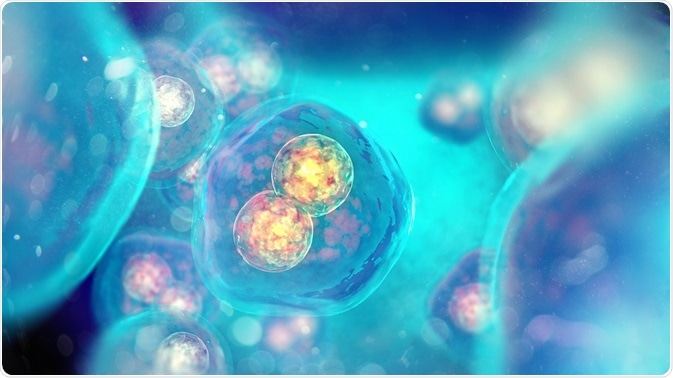A typical mammalian cell contains up to 20,000 types of protein, which must be continually regulated and maintained. The homeostasis of these proteins, also referred to as “proteostasis”, is a complex pathway that functions to maintain all of the proteins within and around a cell.
 Image Credit: Andrii Vodolazhskyi / Shutterstock
Image Credit: Andrii Vodolazhskyi / Shutterstock
Proteostasis ensures that proteins are produced and folded appropriately before they are trafficked to precise locations. It also acts to ensure that abnormal or excess proteins are degraded to prevent the accumulation of unwanted products.
The proteostasis network within human cells contains over 1,400 proteins. This large proteostasis network contains many types of protein which each fulfil a different role.
These proteins include molecular chaperones, co-chaperones, components of the degradation pathway, stress response enzymes, and numerous signaling pathways that work alone or in unison.
Proteostasis and the proteome
The initial stage of regulating the proteome is during the production of proteins. This is carried out by a process called translation by which the ribosome translates the nucleotides sequence within mRNA into an amino acid sequence known as the polypeptide chain. This process contains three sections: initiation, elongation, and termination.
Once this chain of amino acids is complete, it undergoes conformational alteration to form alpha helices or beta sheets depending on the individual characteristics of the amino acids within the chain. For example, hydrophobic residues are placed within the center of the protein structure whereas the hydrophilic residues are placed on the outside. These protein structures then undergo further folding wherein these helices and sheets are arranged into a 3D conformation.
Many regulatory mechanisms are vital for proteostasis. One example is the modification of translation initiation factor, eIF2Aα. This factor usually recruits the Met-tRNA of the 40S ribosome subunit. However, phosphorylation of this factor prevents the recruitment process and reduces the rate of transcription.
Protein folding
Another aspect of the proteostasis network is the correct folding of proteins by chaperones. Chaperones are a family of proteins that bind to unfolded proteins preventing aggregation of polypeptide chains with hydrophobic regions and ensuring that the correct conformation is obtained.
The human genome comprises of 332 chaperones and co-chaperones, each of which have different functions. For example, the heat shock protein (Hsp) 70 binds to the hydrophobic regions of polypeptide chains and therefore prevents it from aggregating with other chains. Hsp60 isolates unfolded proteins and allows them to obtain their 3D conformations without interference from other proteins.
Chaperons are also released in stressful conditions, such as a rise in temperature or changes in pH whereby a heat shock response is initiated. These chaperones then act by protecting the proteins from further misfolding and promote either repair or degradation of damaged proteins.
Proteostasis during protein degradationAnother form of proteostasis is through regulation during degradation. This occurs when proteins are damaged, misfolded or when there is an excess of protein product within or outside of the cell. Degradation also targets regulatory factors in response to external or internal signals.
Several systems are used to degrade proteins such as the ubiquitin proteasome system and autophagic vacuolar (lysosomal) system.
Each system has a unique role. For example, the ubiquitin proteasome system is used to stop mutated proteins from accumulating into high concentrations. Initially, these proteins are targeted by E3 ligases that attach to ubiquitin forming a polyubiquitin chain. The proteasome then recognizes the polyubiquitin chain allowing undesired protein to be targeted and broken down.
Proteostasis in disease and targeted therapies
Loss of proteostasis can result in neurogenerative diseases such as in Alzheimer’s disease, cardiac diseases and other metabolic/genetic disorders. Loss of proteome hemostasis is also linked to aging.
In Alzheimer’s disease, loss of proteostasis leads to misfolding of proteins and build-up of proteins within the brain which impacts signaling between neurons.
Enhanced understanding of the proteostasis network and the protein quality control systems, i.e., chaperones, ubiquitin–proteosomal systems, lysosomal system, and other proteins, has paved way for the development of new therapeutic strategies for conformational diseases.
These strategies are the use of proteostasis regulators to enhance the capacity of the proteostasis network with the use of pharmacological chaperones that specifically bind and rescue misfolded proteins to provide a synergistic effect. Numerous such small molecular compounds are under preclinical and clinical pharmaceutical development.
Further Reading
Last Updated: Aug 22, 2023